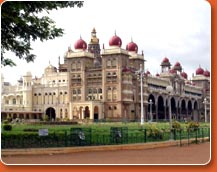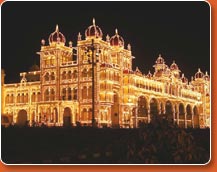- Location: Heart of the city, about one km from Bus Stand, about 3 kms from City Railway Station.
- Visiting Hours: Daily 10 a.m. to 5-30 p.m. (Photography is prohibited inside the Palace, Shoes have to be left outside at the entrance).
- Illumination: 7 p.m. to 8 p.m. on Sundays and public holidays and also during all the 10 days of Dasara celebrations. Entry free through the gates to the open yard.
 Mysore
Palace is one of the most magnificent buildings. It is a sight not to be
missed when it is illuminated on Sundays and festive occasions. The
interior of the Palace is equally worth a visit, for its spacious halls,
called Mantaps, paintings and architectural beauty. The palace is an
excellent combination of Indo-Saracenic architecture. The domes and the
outside construction are of Muslim architecture. But the interior of the
Palace is a fine example of Hindu architecture. Together, it is an
aesthetic blend of Hindu and Muslim architecture. Though the present
Palace is little over a century old, there is clear evidence to show
that there existed a royal structure even when the two Yadu dynasty
princes, Yaduraya and Krishnaraya, came to Mysore in 1399 A.D.
Mysore
Palace is one of the most magnificent buildings. It is a sight not to be
missed when it is illuminated on Sundays and festive occasions. The
interior of the Palace is equally worth a visit, for its spacious halls,
called Mantaps, paintings and architectural beauty. The palace is an
excellent combination of Indo-Saracenic architecture. The domes and the
outside construction are of Muslim architecture. But the interior of the
Palace is a fine example of Hindu architecture. Together, it is an
aesthetic blend of Hindu and Muslim architecture. Though the present
Palace is little over a century old, there is clear evidence to show
that there existed a royal structure even when the two Yadu dynasty
princes, Yaduraya and Krishnaraya, came to Mysore in 1399 A.D.The Mysore chieftain had his residential building here. Mysore remained the capital of the Yadu or Wodeyar dynasty till 1610 when Raja Wodeyar shifted his headquarters from Mysore to Srirangapatna, after defeating the Vijayanagar representative. Till this period, as the Mysore rulers continued to rule their province from Mysore, there must have existed a building appropriate to their stature and needs. We find a clear description of the Mysore Palace as it existed during the period of Kanteerava Narasaraja Wodeyar (1638) and Chikka Devaraja Wodeyar (1673-1704), the earliest description of the Mysore available on record. This clearly indicates that a royal structure existed in Mysore even prior to them.
Kanteerava Narasaraja Wodeyar is credited to have rebuilt the old structure and the fort around it and strengthened it by placing around it eleven powerful guns, each bearing a name. The Palace, probably, did not receive due care after Chikka Devaraja Wodeyar, because of political instability in their kingdom. Historical evidence goes to show that the Palace and the buildings located around it within the fortwalls suffered further when Tipu Sultan embarked upon a project to shift the town to Nazarbad, a distance of about 1.5 kms from the present Palace. There was no building worth the name in Mysore for the coronation of the five-year-old Krishnaraja Wodeyar III, after Tipu died in the battle against the British in 1799. The capital was shifted back to Mysore from Srirangapatna and the ancestral Palace was rebuilt on the same site in the same form as it existed earlier. The model and paintings of this Palace, built chiefly out of wood and mud in Hindu style, can be seen even today. The Maharaja and his family moved to the Palace in 1801. As fate would have it even this hastily built wood and mud structure met with a catastrophe. During the wedding of Jayalakshammanni, the eldest daughter of Chamaraja Wodeyar, in February 1897, a sudden fire destroyed the entire front wing of the wooden Palace. Again the construction of a new palace, a bigger one than that existed, but on the same model and on the same site, was taken up in that year alone and was completed in 1912. During this period, the royal family temporarily lived in the Jaganmohan Palace, which now houses an art gallery. The new palace cost about Rs. 42 lakhs. However, the old portion of the palace was retained and can be seen even now behind the front portion of the new structure.
 Built
out of local material, it is a three-storied structure with a
five-storey tower, the tallest tower with the gilded dome raising to a
level of 145 feet from the ground. Between the seven arches in the
front, there is the "Ane Bagilu" or the elephant gate. Above
it in the first floor, facing east, is the grand Durbar Hall, where the
rulers were holding court during Dasara and on special occasions. Inside
the palace, there are beautiful pavilions or halls - Kalyana Mantap (the
wedding hall), Amba Vilasa (the private durbar hall), Gombe Thotti (hall
of dolls) and rooms with armory and trophies - all built around an open
courtyard. Gombe Thotti and Kalyana Mantap contain life-like paintings
and murals of the Dasara procession of the period of Krishnaraja Wodeyar
IV. It is a reproduction of actual procession of the then ruler. Durbar
Hall and Amba Vilas are used for private functions of the erstwhile
royal family. Stained glasses, huge cast iron pillars, decorated dooms,
murals depicting the famous Dasara celebrations, paintings of Raja Ravi
Varma, beautiful doors and carved figures in panels, friezes and niches
have added to the grandeur of the palace. Behind the main palace, in the
old portion, scion of Mysoer royal family, Srikanta Datta Narasimharaja
Wadiyar has exhibited the royal family artifacts in a private
residential museum.
Built
out of local material, it is a three-storied structure with a
five-storey tower, the tallest tower with the gilded dome raising to a
level of 145 feet from the ground. Between the seven arches in the
front, there is the "Ane Bagilu" or the elephant gate. Above
it in the first floor, facing east, is the grand Durbar Hall, where the
rulers were holding court during Dasara and on special occasions. Inside
the palace, there are beautiful pavilions or halls - Kalyana Mantap (the
wedding hall), Amba Vilasa (the private durbar hall), Gombe Thotti (hall
of dolls) and rooms with armory and trophies - all built around an open
courtyard. Gombe Thotti and Kalyana Mantap contain life-like paintings
and murals of the Dasara procession of the period of Krishnaraja Wodeyar
IV. It is a reproduction of actual procession of the then ruler. Durbar
Hall and Amba Vilas are used for private functions of the erstwhile
royal family. Stained glasses, huge cast iron pillars, decorated dooms,
murals depicting the famous Dasara celebrations, paintings of Raja Ravi
Varma, beautiful doors and carved figures in panels, friezes and niches
have added to the grandeur of the palace. Behind the main palace, in the
old portion, scion of Mysoer royal family, Srikanta Datta Narasimharaja
Wadiyar has exhibited the royal family artifacts in a private
residential museum.The colourful Dasara procession starts from the precincts of the Palace.



